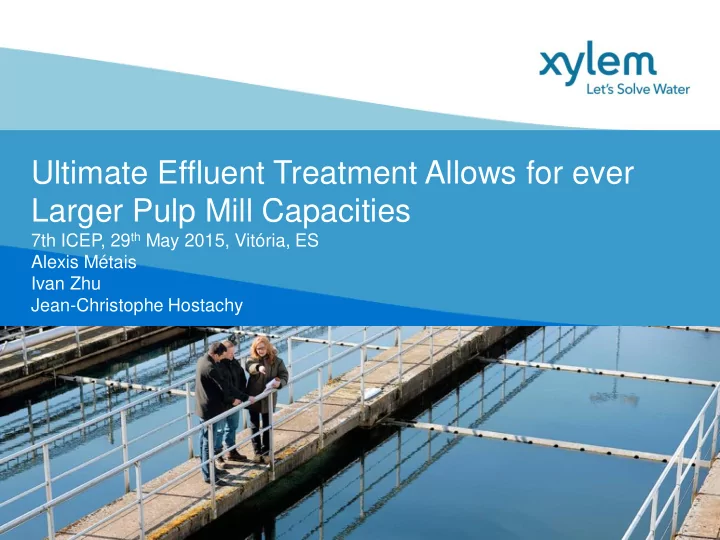

Ultimate Effluent Treatment Allows for ever Larger Pulp Mill Capacities 7th ICEP, 29 th May 2015, Vitória, ES Alexis Métais Ivan Zhu Jean-Christophe Hostachy
Environmental Impact Pulp mill effluent quality is mostly characterized today by its COD load. Environmental impact of modern pulps mill is assessed according to the COD discharge and the capacity of receiving waters to sustain it. 2
Achievements Environmental impact of modern pulps mill has been drastically improved since the 1990s thanks to implementation of: - oxygen delignification allowing filtrate recovery - secondary effluent treatments 3
Better Environmental Impact – Case of Finland Specific COD discharge decreased by 69% per produced ton since 1992. Source: http://www2.forestindustries.fi/statistics/60-Environment 4
Better Specific or Overall Environmental Impact? However fiberline capacities have been increasing: • 500,000 adt/y at Alberta-Pacific (Canada) in 1993 • 1 million adt/y at Hainan Jinhai (China) in 2004 • 1.5 million adt/y at Eldorado Três Lagoas (Brazil) in 2012 Despite specific COD discharge was divided by 3 since 1992, it is balanced by the threefold increase of fiberline capacity. Actually COD discharge at one single point is potentially the same as 20 years ago. 5
Alternatives It is possible to keep increasing pulp mill capacities without increasing COD discharge by: • further circulating bleaching filtrates to the recovery if lowering the use of chlorine dioxide • implementing tertiary effluent treatments allowing fulfilling with discharge limits or even reuse of treated effluent in the process. 6
Tertiary Treatment Techniques Tertiary treatment target is already in some sensitive locations to divide by half the COD at the outlet of the secondary treatment plant. Coagulation / Flocculation is the traditional tertiary effluent process. It has proved successful but results in high amounts of sludge which are difficult and costly to handle. 7
Conventional Tertiary Effluent Treatment: Dissolved Air Flotation (Coagulation/Flocculation) Alternative Oxidant Injection Point Filtration Major Coagulant Injection Together with a Reducing Reagent Raw Water Treated Oxidant Injection Water COD load is precipitated and transferred to a solid phase (sludge). 8
Clean Tertiary Effluent Treatment: Ozone & Biofiltration Combination COD is destroyed in-situ through chemical and biological oxidation 9
Experimental A pulp mill producing bleached eucalyptus kraft pulp was requesting a new solution to reduce at the outlet of the existing ETP. Day 1 2 3 4 5 6 7 Average Inlet COD mg/L 147 126 132 101 116 144 147 130 Inlet color Pt-Co Units 207 169 209 135 148 192 207 181 A pilot system combining ozone, biofiltration (BAFF) and Coagulation/Flocculation (DAF) was installed after their secondary biological treatment 10
Objective The main objective of the piloting is to compare the three following alternatives • DAF (Coagulation & Flocculation) • Ozone + BAFF (Biofiltration) • Ozone + DAF Results are given for a COD removal of 40% and 60%, and economic calculation is carried for a 50,000 m 3 /d effluent flow with 130 mg/L COD (outlet of the existing secondary treatment). 11
DAF Results COD outlet = COD inlet – PACl dose in mg/L x 0.2 DAF treatment would require: • (130 - 78) / 0.2 = 260 mg/L PACl for 40% removal • (130 - 52) / 0.2 = 390 mg/L PACl for 60% removal 12
O 3 + BAFF Results COD outlet = COD inlet – ozone dose in mg/L – 20 mg/L Combined ozone and BAFF treatment would require (130 – 78 – 20) x 1 = 32 mg/L ozone for 40% removal. 13
O 3 + DAF Results COD outlet = COD inlet – ozone dose in mg/L – PACl dose in mg/L x 0.26 Changing hydrophilic behavior of macromolecules, ozone strongly helps PACl action during DAF 14
O 3 + DAF Results Increasing the ozone dose has no significant impact on the O 3 + DAF treatment. 15
O 3 + DAF Results Combined ozone and DAF treatment would require 10 mg/l ozone + • (130 - 78 – 10) / 0.26 = 162 mg/L PACl for 40% removal • (130 - 52 – 10) / 0.26 = 262 mg/L PACl for 60% removal Compared to DAF alone, the PACl dosage is reduced by one third thanks to ozone. 16
Economics To build an OPEX/CAPEX comparison, the following costs are considered: - 100 $/MWh - 100 $/ton of oxygen - 300 $/ton of PACl - 50 $/ton for tertiary sludge disposal 17
OPEX for 40% COD Removal Tertiary Treatment DAF O 3 +DAF O 3 +BAFF PACl dose, mg/L 260 162 0 Daily PACl costs, $/day 3,900 2,423 0 Sludge production, ton/day 3.6 2.2 0.0 Daily sludge disposal costs, $/day 179 111 0 Ozone dose, mg/L 0 10 32 Daily ozone costs, $ 0 915 2,928 OPEX, $/day 4,079 3,449 2,928 18
OPEX for 60% COD Removal Tertiary Treatment DAF O 3 +DAF PACl dose, mg/L 390 262 Daily PACl costs, $/day 5,850 3,930 Sludge production, ton/day 5.4 3.6 Daily sludge disposal costs, $/day 268 180 Ozone dose, mg/L 0 10 Daily ozone costs, $ 0 915 Daily OPEX, $/day 6,118 5,025 19
Conclusions It is possible to efficiently reduce by half COD discharge at the outlet of an existing ETP. The combination O 3 + BAFF allows for • Lower tertiary treatment operating costs • “Real” elimination of COD through oxidation. • No sludge generation The combination of O 3 + DAF is possible in existing DAF installations, resulting in significant decrease of PACl dose and corresponding sludge volume. 20
Conclusions Economics show that OPEX are drastically reduced. Compared to conventional DAF, payback of O 3 + BAFF is lower than 5 years with a 40% COD removal target. Introducing an ozone treatment ahead of an existing DAF treatment has a payback of: • 4 years with a 40% COD removal target • 2 years with a 60% COD removal target But each situation is a specific case! 21
Sustainable development is your ambition… Ozone bleaching is our solution! Fibria Jacarei, Brazil Thank you for your attention! 22 Confidential
Recommend
More recommend